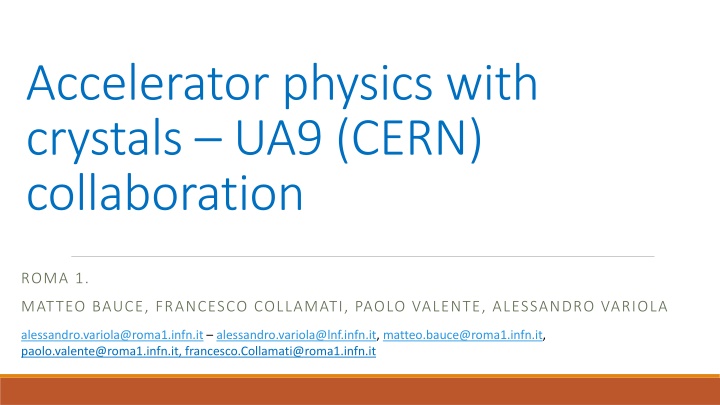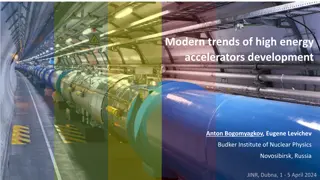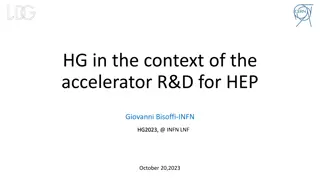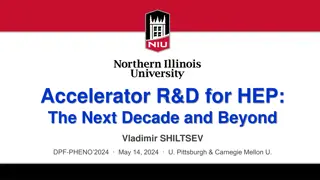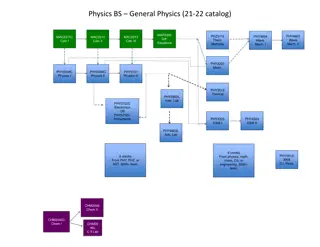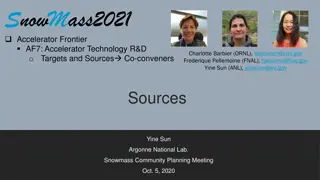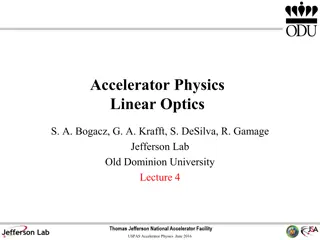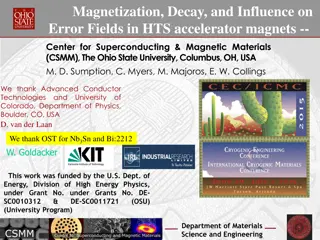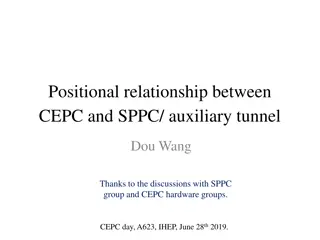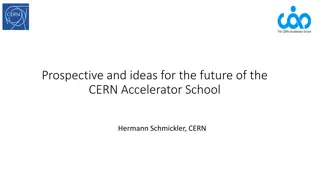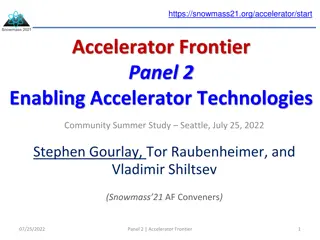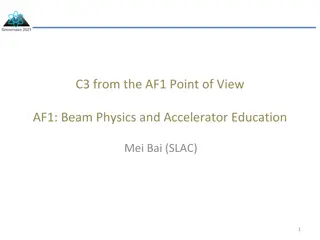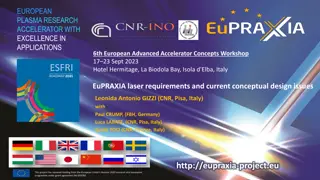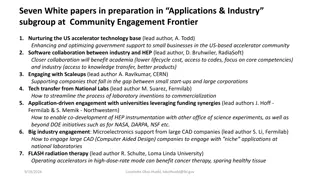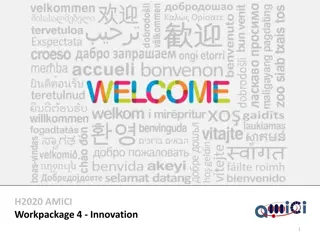Future of Crystals in Accelerator Physics Collaboration
Crystals play a crucial role in accelerator technology, offering high magnetic fields for particle manipulations and coherent effects for various applications. The UA9 collaboration at CERN has been actively involved in studying crystal interactions and developing innovative solutions for particle accelerators from 2009 to 2019. The collaboration involves various scientific activities such as collimation, extraction, and double channeling in different particle accelerator facilities. Looking ahead to 2021-2026, the UA9 collaboration plans to continue its research with a focus on analyzing, operating, and simulating crystal technologies for enhanced performance in particle accelerators.
Download Presentation

Please find below an Image/Link to download the presentation.
The content on the website is provided AS IS for your information and personal use only. It may not be sold, licensed, or shared on other websites without obtaining consent from the author.If you encounter any issues during the download, it is possible that the publisher has removed the file from their server.
You are allowed to download the files provided on this website for personal or commercial use, subject to the condition that they are used lawfully. All files are the property of their respective owners.
The content on the website is provided AS IS for your information and personal use only. It may not be sold, licensed, or shared on other websites without obtaining consent from the author.
E N D
Presentation Transcript
Accelerator physics with crystals UA9 (CERN) collaboration ROMA 1. MATTEO BAUCE, FRANCESCO COLLAMATI, PAOLO VALENTE, ALESSANDRO VARIOLA alessandro.variola@roma1.infn.it alessandro.variola@lnf.infn.it, matteo.bauce@roma1.infn.it, paolo.valente@roma1.infn.it, francesco.Collamati@roma1.infn.it
Crystals are one of the most interesting technology to be study for the future accelerator technology - They can provide extremely high magnetic fields for VHEP particle manipulations (proton and muon colliders) - Curved crystals, special shapes are possible introducing also a focalizing component. - In crystals, channeled particles minimize the multiple scattering contributions. - Crystals provide coherent effects for light particles -> Radiation emission and possible application in medical physics (and others) - At low energy possible application for slow spill extraction in medical machines matching the patient breath - Very compact elements ..and many others
UA UA9 9 Scientific Activity from Scientific Activity from 2009 2009 - -2019 2019 : Where ? : Where ? Particles Crystal interaction on North Area - H8 : (Channeling & Nuclear Interaction) CMS strip detectors CMS strip detectors Beam Pipe Beam Pipe Gonio on AIR Particles Crystal interaction in SPS : (Collimation, Extraction, Double Channeling) Timepix or Tcherenkov Roman Pot Gonio in Vacuum Beam Pipe Beam Pipe PNPI CERN-LNF Particles Crystal interaction in LHC : (Collimation) Beam Loss Monitor Gonio in Vacuum Beam Pipe Beam Pipe CERN
UA UA9 9 Summary Summary 2009 2009 - -2019 2019 Collaboration : CERN Italy Russia UK FRANCE EN-Collimation-Extraction SPS, LHC, NA-H8, Analysis, Operations, Simulation INFN : LNF, NA, Roma1, FE Crystals, Analysis, Detectors (GEM, Timepix, Tcherencov, Trigger) , Mechanics, Optics, Simulation PNPI Crystals, Gonio, Crystal allignment Imperial College Silicon strip telescope IN2P3 Cherencov diagnistics, Analysis UA9 Results : Crystal R&D and Characterization Double Channeling Heavy Ions Collimation Proton Collimation Beam Extraction Septum shadowing North Area H8 & SPS SPS SPS & LHC SPS & LHC SPS SPS
Crystals Future 2021 - 2026 UA9 Collaboration : CERN Italy Russia UK EN-STI, SPS, NA-H8 Analysis, Operations, Simulations INFN : LNF, NA, Roma1 PNPI, IHEP, JINP Imperial College Analysis, Detectors (Timepix Telescope, Ecal) , Mechanics, Beam Optics, Simulation Crystals, Crystal allignment, Simulations, Theory Silicon strip telescope UA9 Future Scientific Activity : Crystal characterization with muon beams (+/-) Muon energy losses and radiation emission Protons and Muon Coalescence and Merging Bending crystal angular PSF Crystal R&D and Characterization North Area H8 North Area H8 North Area H8 North Area H8 North Area H8 Possible Assistance to Crystal CERN Operation Activity : Crystal Characterization LHC Collimation SPS extraction Double Channeling Beam Instrumentation LHC SPS SPS (later on LHC?)
1) Crystal characterization with muons CONTEXT : future muon accelerators beam merging and manipulation Very important is the characterization of both sign particles in VR regime. The result should open the way for a recombination scheme very efficent for both beams (+/-).
SET UP - - - - - Curved and planar crystal to be measured. Goniometer One magnetic dipole with Power supply Une position measurement strip(Medipix?) for the integrated energy losses measurement One Ecal to measure the radiative component Si strip Goniometer & crystal beam beam beam Ecal Dipole Radiation Radiation
Ecal radiation measurements (G.Hall) Reminder: ECAL readout architecture One Serenity for tracker and ECAL FE board uses existing MGPA preamps FPGA to be on external FC7 modest firmware requirements APDs larger than original CMS devices Can run with same gain (adjustable by HV) ADC 16-bit part selected ECAL BW requirement estimate later Single Serenity communicates with front-ends in the test run -Expected event size : 1Kb (Tk) -Output data split across 4 servers via 10 Gbps Ethernet (UDP) -Empty frames from beam gaps forwarded in addiction to in spill data -From switch to EOS/CTA with 20Gbps
The merging importance The merging importance . . ? ?1?2 4??? ? ?2 4??2 HEAD on Collisions and symmetrical - cylindrical beams L= HEAD on Collisions L= ?? given by the bunches characteristics (SQRT(emittance)) and accelerator lattice ( function). This trigger the interest for the beam cooling in colliders f =Number of bunches x Frep -> It is much more convenient to have 1 x 10exp10 particles bunch than 10x10exp9 N In a given emittance is mainly produced by the source characteristics. Then, in the past, we had two kind of colliders : 1) Synchrotron cooling effective (leptons). The machine has not the source memory 2) Synchrotron cooling not effective (Hadrons). The machine has the source memory Muons? (like 1 at very high energy for human B fields ) FOR THIS REASONS IT IS VERY IMPORTANT IF WE CAN MERGE TWO BUNCHES (transv or long)
Why it is so difficult ? To mix to beams I have to apply a force to one beam and to to the other one!!!!! This linear force does not exist for beams of the same charge (the ones that we want to mix in the colliders .) Beam 1 Beam 1 Beam 2 Beam 2 But in an ideal world we can have something that plays the angular filter Role that we are looking for -> curved crystal!!
Example : Merging in MAP 134 m -> around half microsec!!!! of the rest lifetime!!!
Proposed Principle of beam merge/coalescence in crystals: The principle is to merge the two beams by taking advantage from the regime of channeling, VR and Amorphous for particle beams impinging on the crystal from different directions No CH Beam CH Window selection
Two experiments classes: Integrated : the two beams are simulated by the crystal rotation. The two resulting populations are subsequently overimposed Simultaneous : With a first crystal we separate a fraction of the incoming beam and by means of another crystal we reinject it so testing the synchro merging on two phase space population
Following different theories this experiment should represent a FIRST partial violation of the Liouville theorem, a fundamental theorem of statistical physics that represent a true foudation stone of particle accelerator physcis
4) Bending crystal angular PSF This is a FUNDAMENTAL measurements in the crystal physics field. - - - negligible in respect to the critical angle. Question : what is the distribution after the crystal in CH and VR regime for a delta of dirac input? This will set the limit of application for the recombinations schemes once the 4D emittance are considered The measurement is extremely challenging due to the multiple scattering contribution in the Si strips that must be Work to be performed in strict collaboration with the CERN accelerator phisicist to require a input beam with reduced angular spread (fraction of c) - - A experimental procedure and set up reducing the number of strips should be implemented R&D on thin detectors
A possible spin off (CSN5 Grant) Crystal for medical physics. Beam extraction, Crystal efficiency at low energy long crystals (med physics, Grant CSN5 application) CNAO -The real trigger for the crystal application to medical physics -No existing results -Medical Applications : Medical machine extraction strategy. Tunability on the patient characteristics (breath, etc ). Possible application for local beam steering needs a careful evaluation of the efficiency results of this activity -The best partners (CNAO and Medaustron)
TECHNOLOGICAL R&D In kind contribution - For beam merging -> trade off between Channeling / VR efficiency and multiple scattering contribution - For beam merging -> Test of cuved focalizing crystals, to reduce the multiple scattering contribution - For beam merging -> Efficiency of VR in lateral injection - For crystal PSF -> Large critical angle crystals - For extraction, injection (also for medical physics) -> Long crystals efficiency
